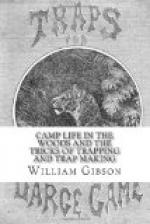[Illustration: b]
[Page 259] BOAT BUILDING.
Where trapping is carried on along the banks of the lakes and rivers, a boat of some kind becomes almost a positive necessity.
[Illustration]
The following examples represent those in most general use. Perhaps the most common form of the “rough and ready” order of boats, is that called the—
“DUG-OUT,” OR LOG CANOE.
It’s general appearance is well indicated by the accompanying illustration. With the proper tools, one of these canoes is easily made. A sharp axe, an adze, a shaving knife, a round edged adze, and a small auger, are principally necessary; and a cross-cut saw, broad-axe, sledge, and large sized chisel, will also be found useful.
In any case the log should not be much less than two feet in diameter, perfectly sound, and free from knots. If this precaution is observed, the result will be all the more satisfactory, and the canoe can be cut so thin, as to render it a light burden; being easily carried on the shoulders.
A pine log is generally chosen for a dug-out, on account of the lightness of the wood, and the ease with which it can be worked. Butternut, cottonwood and whitewood, are also excellent, and indeed almost any sound log of large size will answer the purpose.
For a dug-out of good size, the log should be ten or more feet in length. The first thing to be done is to cut a flat surface on one side of the log, from end to end. This indicates the bottom of the canoe. On the upper side the wood should be hewn away, in the curve shown on the upper outline of our illustration.
[Page 260] It is well to divide the log by notches into three equal lengths. In the centre division, the wood may be cut down to a straight line to a depth of about eight inches from the upper surface. The gradual curve to the bow and stern of the canoe should start from each end of this flat cut, and extend to the upper edge of the log, the guiding line being made on the sides of the log by a piece of chalk. The adze will come into good use in trimming off the wood on these curves. When this upper outline is accomplished, the log may be turned bottom side up, and the sides of the extremities rounded off. This may be done with an axe and adze, and when performed, the bottom curves should be made by chopping away the wood in the curves shown in the lower outline of our illustration. This curve should also be marked out with chalk, and should commence a little nearer the end of the log than the curve on the upper side. Shave off the wood to a blunt edge on this curve, at both bow and stern. The rough form of the canoe is now obtained, and by the aid of the draw-knife, or shaving-knife, it can be neatly and smoothly finished.




